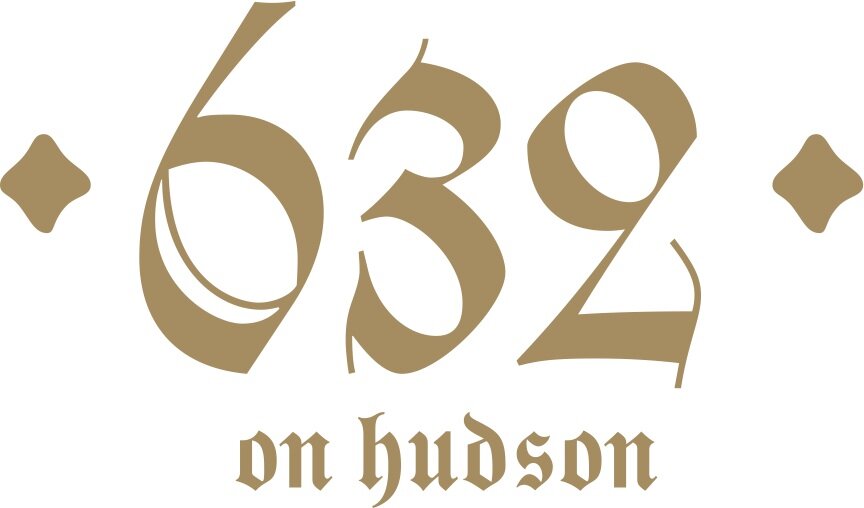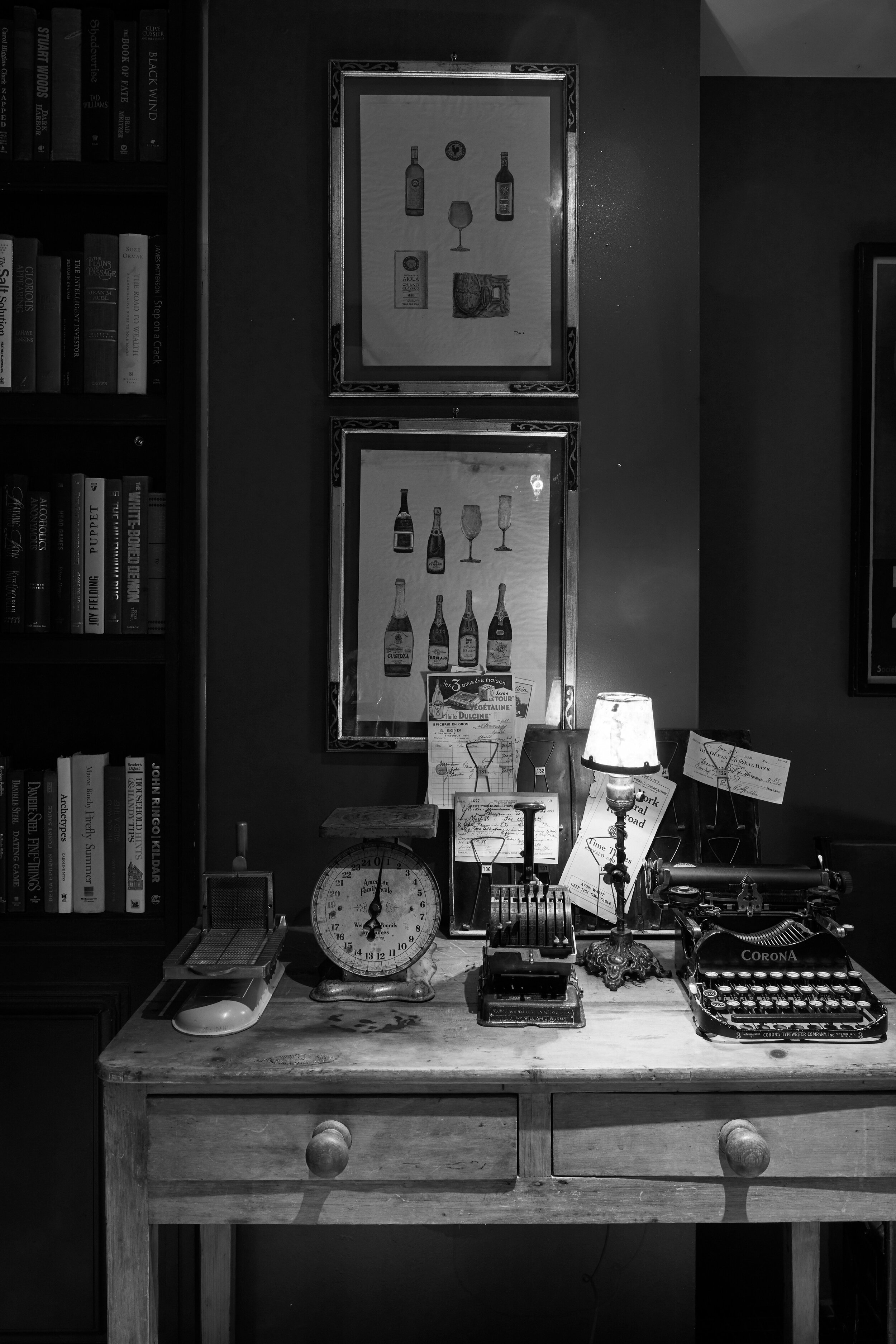
History
Overview
Originally built in 1847 as a townhouse for the family of a sashmaker, 632 Hudson Street was converted to a general store and produce market late in the 19th century by Hugh King, whose name appears on the pediment.
Purchased by the Esteve family in the 1930's, the building became home to an import export business and chorizo sausage factory, which it remained until 1992.
In that year, the present owner Karen Lashinsky and her mother purchased the building, painstakingly restoring and renovating it over a period of twenty-five years which led to its present incarnation as 632 on Hudson and 632 Below.
Part 1: Early History
Both 630 and 632 Hudson Street were built in 1847. At this time nearby Abingdon Square was essentially still farmland.
The Landmark Designation Report reads:
"These two brick houses are four stories high, rising slightly above their neighbors to the south. They share a cornice with dominant central pediment, added at a later date. There are stores at the ground floor and windows above them, all of nearly equal height. They were built for Stephen Kane (No. 630) and for the estate of Richard Towning (No. 632) as part of the development of the area."
Part 2: Hugh King and his Fine Foods Store
In 1881 both buildings were purchased by Hugh King, who had arrived in New York from Ireland to make his fortune, reputedly with only ten dollars in his pocket.
He operated an import business and general store, purveying fine whiskies, wines and brandies among other goods, and owned the buildings until the start of World War II.
This particular owner left a clear imprint on the buildings; from across the street one can make out the faded letters of the words "fine whiskies and wine", and "Hugh King 1881" is visible on the pediment to this day. It is very likely that the early 20th century saw the arrival of the original speakeasy in the basement.
Part 3: The Sausage Factory
Before the Meatpacking District became the nightlife hotspot it is today, it was home to businesses such as the Esteve Packing Corporation, which acquired 632 Hudson Street in 1939 in order to operate an import export business and sausage factory.
Among the imports were Spanish nougat, guava products from Cuba, Canadian salt codfish, as well as rice and beans. Manufacturing mainly Spanish-style sausages such as sobrasada, butifarra and longoniza, the factory also produced Esteve brand olives, olive oil and capers.
Due to a Federal regulation overseeing the packing of meat at the time, a small windowless office was home to an ever-present inspector from the Department of Agriculture.
Part 4: A dream
By 1992 the old sausage factory was a rotting ruin, the walk-in refrigerators, the meathooks and meat racks and chopping tables, the rope-operated elevator long abandoned. The building was so dilapidated that visitors were forced to sign a liability waiver before entering.
But to Karen Lashinsky, the place was full of wonder and opportunity - she imagined a large open space in the middle where there was at the time nothing but a simple elevator shaft.
Together with her mother, Dr. Bertha Lashinsky, a psychoanalyst, Karen purchased the building, determined to transform the vacant factory into a beautiful home.
Part 5: New Again - the Renovation
The building was completely redesigned and reconfigured in a year-long renovation. The centers of the third and fourth floors were torn out to create a soaring 40-foot atrium, wrapped in a grand staircase with railings salvaged from an Upper East Side hotel. At the top of the atrium, the rooftop cabin that housed the old elevator became a cupola, its underside painted by a set designer to mimic a Renaissance mural complete with flying cherubim. During her travels while on tour with the experimental theater company The Wooster Group, Karen had gathered inspiration and artifacts from every corner of the globe. She had found an opportunity to put it all together.
Whenever possible the original historical elements of the building were preserved; old floorboards cleaned, treated and reused, beams and brick left exposed. In some cases it was necessary to get creative; the concrete of the "new" fireplace was rubbed by hand with coffee and mustard to give it an aged-by-time feel.
Today the building is an ever-evolving labor of love for Karen- full of fantasy, romance and imagination. Following the filming of The Real World's 10th season within its walls, Lashinsky made the building available for photo and film shoots, celebratory events as well as for living.
The personality and history of the building remain strong and ever-changing, growing with each new visitor.
Reviving the Legend
The Speakeasy at 632 on Hudson (AKA “Maisie Below”)
By the year 1919, many thought the artistic heyday of Greenwich Village was over. That changed, almost overnight, when the 18th Amendment became law, alcohol was prohibited, and the Village became the nation’s speakeasy capital. Social life was driven underground; the writers and artists returned; the music played, the flappers flapped: the popularity of the neighborhood soared. Greenwich Village, once again became the chosen destination — the only destination — for writers, artists, musicians, thinkers, revolutionaries, their enablers, their admirers, and their enemies — in New York City. An American Left Bank. In 1920, in the drinking holes, cabarets, dance halls, and salons of Village speakeasies, a neighborhood became legendary.
Now, the Speakeasy at 632 on Hudson revives the legend.
Members enter from an unmarked door on Hudson Street between Jane and Horatio Streets, enter an 1847 former sausage factory, cross through our hiden kitchen, knock on the cupboard door, and enter a world where New York’s past lives on, elbow to elbow with the city’s present and future.
A restaurant. A music hall. A quiet bar and sanctuary. A meeting place for Bolsheviks and bankers. A Dadaist safe-house and a place to unwind from the office. A private club that is a world away from anything else in New York and yet at the center of everything.





